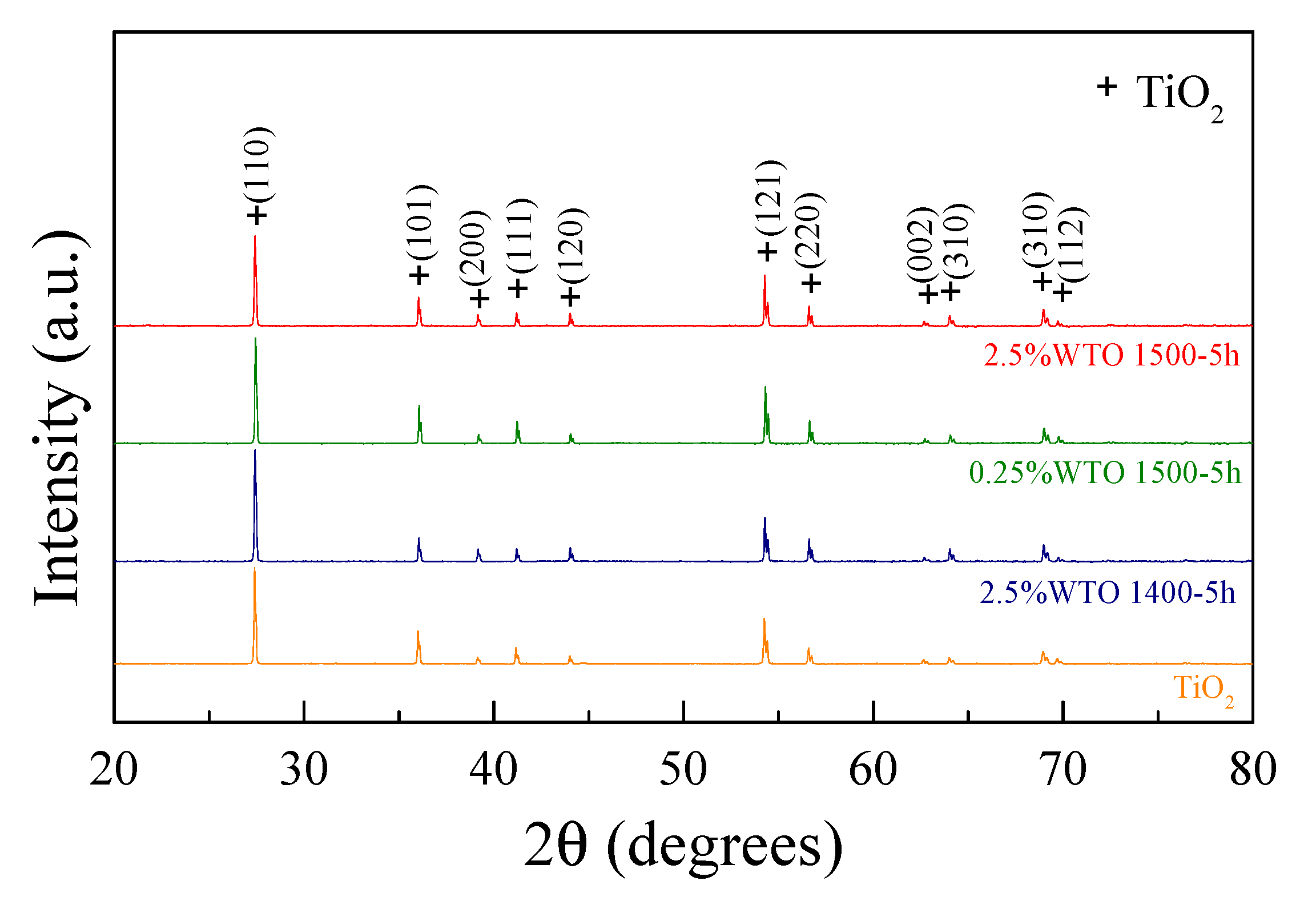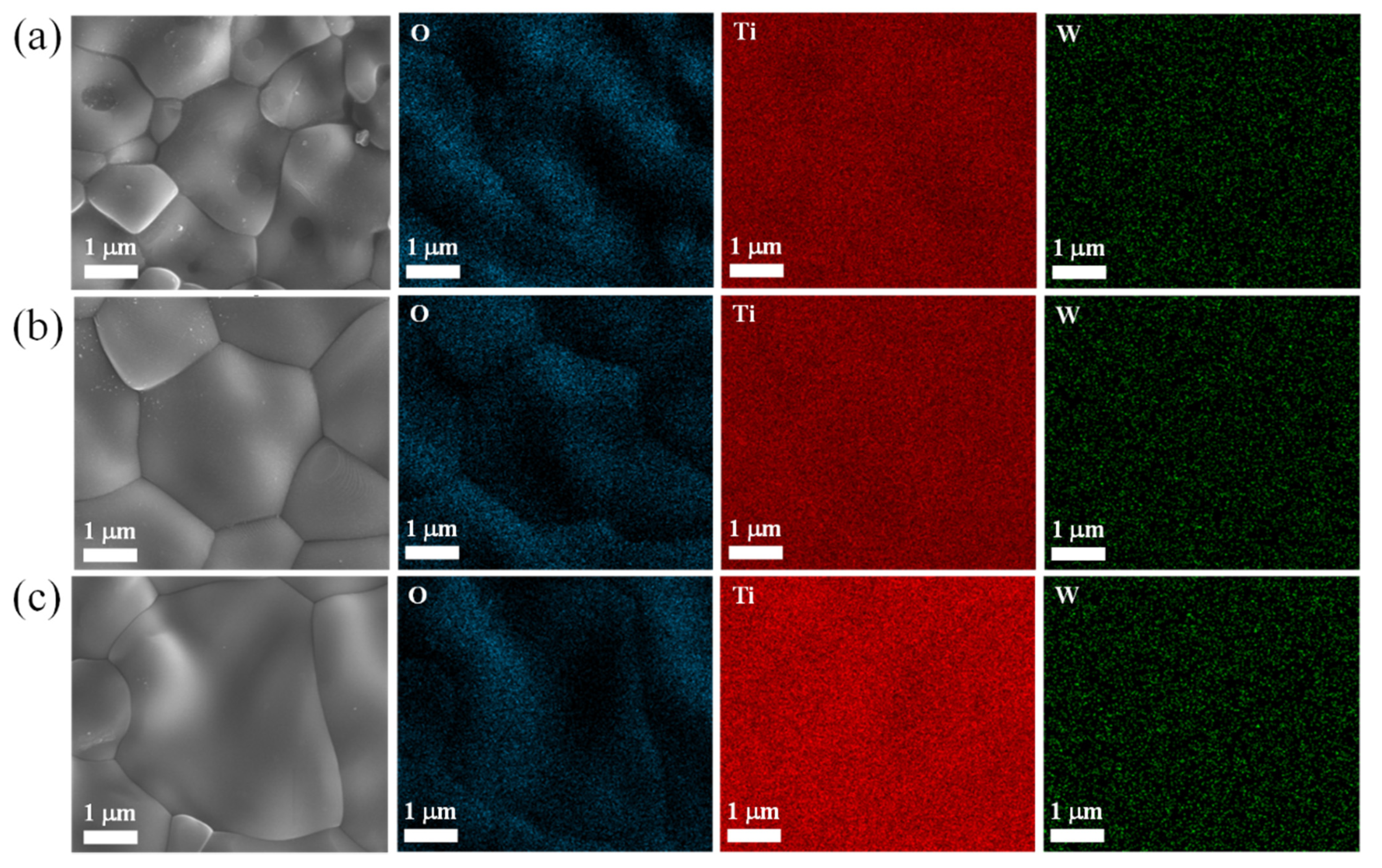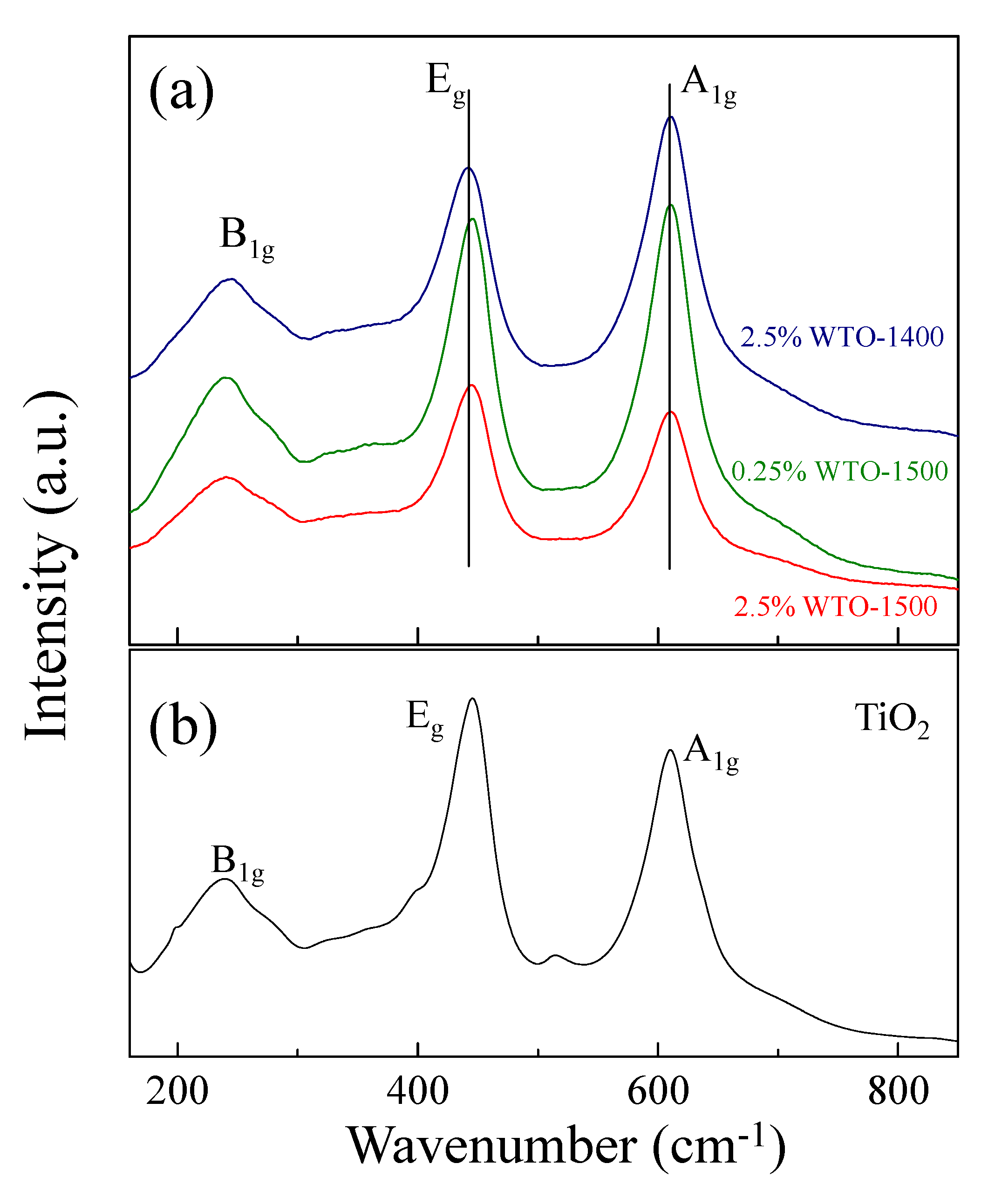Giant Dielectric Properties of W6+-Doped TiO2 Ceramics
Abstract
:1. Introduction
2. Experimental Details
3. Results and Discussion
4. Conclusions
Author Contributions
Funding
Institutional Review Board Statement
Informed Consent Statement
Data Availability Statement
Acknowledgments
Conflicts of Interest
References
- Subramanian, M.A.; Li, D.; Duan, N.; Reisner, B.A.; Sleight, A.W. High Dielectric Constant in ACu3Ti4O12 and ACu3Ti3FeO12 Phases. J. Solid State Chem. 2000, 151, 323–325. [Google Scholar] [CrossRef]
- Wang, Y.; Jie, W.; Yang, C.; Wei, X.; Hao, J. Colossal Permittivity Materials as Superior Dielectrics for Diverse Applications. Adv. Funct. Mater. 2019, 29, 1808118. [Google Scholar] [CrossRef]
- Peng, Z.; Zhou, X.; Wang, J.; Zhu, J.; Liang, P.; Chao, X.; Yang, Z. Origin of colossal permittivity and low dielectric loss in Na1/3Cd1/3Y1/3Cu3Ti4O12 ceramics. Ceram. Int. 2020, 46, 11154–11159. [Google Scholar] [CrossRef]
- Peng, Z.; Wu, D.; Liang, P.; Zhou, X.; Wang, J.; Zhu, J.; Chao, X.; Yang, Z. Grain boundary engineering that induces ultrahigh permittivity and decreased dielectric loss in CdCu3Ti4O12 ceramics. J. Am. Ceram. Soc. 2020, 103, 1230–1240. [Google Scholar] [CrossRef]
- Du, G.; Wei, F.; Li, W.; Chen, N. Co-doping effects of A-site Y3+ and B-site Al3+ on the microstructures and dielectric properties of CaCu3Ti4O12 ceramics. J. Eur. Ceram. Soc. 2017, 37, 4653–4659. [Google Scholar] [CrossRef]
- Wu, J.; Nan, C.-W.; Lin, Y.; Deng, Y. Giant Dielectric Permittivity Observed in Li and Ti Doped NiO. Phys. Rev. Lett. 2002, 89, 217601. [Google Scholar] [CrossRef]
- Wang, J.; Liu, G.; Jia, B.W.; Liu, X.Q.; Chen, X.M. Giant dielectric response and polaronic hopping in Al-substituted A5/3Sr1/3NiO4 (A=La, Nd) ceramics. Ceram. Int. 2014, 40, 5583–5590. [Google Scholar] [CrossRef]
- Hu, W.; Liu, Y.; Withers, R.L.; Frankcombe, T.J.; Norén, L.; Snashall, A.; Kitchin, M.; Smith, P.; Gong, B.; Chen, H.; et al. Electron-pinned defect-dipoles for high-performance colossal permittivity materials. Nat. Mater. 2013, 12, 821–826. [Google Scholar] [CrossRef]
- Li, J.; Li, F.; Li, C.; Yang, G.; Xu, Z.; Zhang, S. Evidences of grain boundary capacitance effect on the colossal dielectric permittivity in (Nb + In) co-doped TiO2 ceramics. Sci. Rep. 2015, 5, 8295. [Google Scholar] [CrossRef] [Green Version]
- Li, J.; Li, F.; Xu, Z.; Zhuang, Y.; Zhang, S. Nonlinear I–V behavior in colossal permittivity ceramic: (Nb+In) co-doped rutile TiO2. Ceram. Int. 2015, 41 (Suppl. 1), S798–S803. [Google Scholar] [CrossRef]
- Wu, Y.Q.; Zhao, X.; Zhang, J.L.; Su, W.B.; Liu, J. Huge low-frequency dielectric response of (Nb,In)-doped TiO2 ceramics. Appl. Phys. Lett. 2015, 107, 242904. [Google Scholar] [CrossRef]
- Nachaithong, T.; Kidkhunthod, P.; Thongbai, P.; Maensiri, S. Surface barrier layer effect in (In+Nb) co-doped TiO2 ceramics: An alternative route to design low dielectric loss. J. Am. Ceram. Soc. 2017, 100, 1452–1459. [Google Scholar] [CrossRef]
- Hu, W.; Lau, K.; Liu, Y.; Withers, R.L.; Chen, H.; Fu, L.; Gong, B.; Hutchison, W. Colossal Dielectric Permittivity in (Nb+Al) Codoped Rutile TiO2 Ceramics: Compositional Gradient and Local Structure. Chem. Mater. 2015, 27, 4934–4942. [Google Scholar] [CrossRef]
- Song, Y.; Wang, X.; Zhang, X.; Sui, Y.; Zhang, Y.; Liu, Z.; Lv, Z.; Wang, Y.; Xu, P.; Song, B. The contribution of doped-Al to the colossal permittivity properties of AlxNb0.03Ti0.97−xO2 rutile ceramics. J. Mater. Chem. C 2016, 4, 6798–6805. [Google Scholar] [CrossRef]
- Liu, G.; Fan, H.; Xu, J.; Liu, Z.; Zhao, Y. Colossal permittivity and impedance analysis of niobium and aluminum co-doped TiO2 ceramics. RSC Adv. 2016, 6, 48708–48714. [Google Scholar] [CrossRef]
- Peng, H.; Shang, B.; Wang, X.; Peng, Z.; Chao, X.; Liang, P.; Yang, Z. Origin of giant permittivity in Ta, Al co-doped TiO2: Surface layer and internal barrier capacitance layer effects. Ceram. Int. 2018, 44, 5768–5773. [Google Scholar] [CrossRef]
- Dong, W.; Hu, W.; Berlie, A.; Lau, K.; Chen, H.; Withers, R.L.; Liu, Y. Colossal Dielectric Behavior of Ga+Nb Co-Doped Rutile TiO2. ACS Appl. Mater. Interfaces 2015, 7, 25321–25325. [Google Scholar] [CrossRef]
- Wang, Z.; Chen, H.; Wang, T.; Xiao, Y.; Nian, W.; Fan, J. Enhanced relative permittivity in niobium and europium co-doped TiO2 ceramics. J. Eur. Ceram. Soc. 2018, 38, 3847–3852. [Google Scholar] [CrossRef]
- Wang, M.; Xie, J.; Xue, K.; Li, L. Effects of Eu3+/Ta5+ nonstoichiometric ratio on dielectric properties of (EuxTa1−x)0.08Ti0.92O2 ceramics with colossal permittivity: Experiments and first-principle calculations. Ceram. Int. 2021, 47, 24868–24876. [Google Scholar] [CrossRef]
- Wang, Z.; Chen, H.; Nian, W.; Fan, J.; Li, Y.; Wang, X.; Ma, X. Grain boundary effect on dielectric properties of (Nd0.5Nb0.5)xTi1−xO2 ceramicsceamics. J. Alloys Compd. 2019, 785, 875–882. [Google Scholar] [CrossRef]
- Xu, Z.; Li, L.; Wang, W.; Lu, T. Colossal permittivity and ultralow dielectric loss in (Nd0.5Ta0.5)xTi1−xO2 ceramics. Ceram. Int. 2019, 45, 17318–17324. [Google Scholar] [CrossRef]
- Li, J.; Zeng, Y.; Fang, Y.; Chen, N.; Du, G.; Zhang, A. Synthesis of (La + Nb) co-doped TiO2 rutile nanoparticles and dielectric properties of their derived ceramics composed of submicron-sized grains. Ceram. Int. 2021, 47, 8859–8867. [Google Scholar] [CrossRef]
- Cao, Z.; Zhao, J.; Fan, J.; Li, G.; Zhang, H. Colossal permittivity of (Gd + Nb) co-doped TiO2 ceramics induced by interface effects and defect cluster. Ceram. Int. 2021, 47, 6711–6719. [Google Scholar] [CrossRef]
- Li, Z.; Wu, J. Novel titanium dioxide ceramics containing bismuth and antimony. J. Mater. 2017, 3, 112–120. [Google Scholar] [CrossRef]
- Yang, C.; Tse, M.-Y.; Wei, X.; Hao, J. Colossal permittivity of (Mg + Nb) co-doped TiO2 ceramics with low dielectric loss. J. Mater. Chem. C 2017, 5, 5170–5175. [Google Scholar] [CrossRef]
- Liang, P.; Zhu, J.; Wu, D.; Peng, H.; Chao, X.; Yang, Z. Good dielectric performance and broadband dielectric polarization in Ag, Nb co-doped TiO2. J. Am. Ceram. Soc. 2021, 104, 2702–2710. [Google Scholar] [CrossRef]
- Peng, H.; Liang, P.; Wu, D.; Zhou, X.; Peng, Z.; Xiang, Y.; Chao, X.; Yang, Z. Simultaneous realization of broad temperature stability range and outstanding dielectric performance in (Ag+, Ta5+) co–doped TiO2 ceramics. J. Alloys Compd. 2019, 783, 423–427. [Google Scholar] [CrossRef]
- Zhu, J.; Wu, D.; Liang, P.; Zhou, X.; Peng, Z.; Chao, X.; Yang, Z. Ag+/W6+ co-doped TiO2 ceramic with colossal permittivity and low loss. J. Alloys Compd. 2021, 856, 157350. [Google Scholar] [CrossRef]
- Peng, Z.; Wu, D.; Liang, P.; Zhu, J.; Zhou, X.; Chao, X.; Yang, Z. Understanding the ultrahigh dielectric permittivity response in titanium dioxide ceramics. Ceram. Int. 2020, 46, 2545–2551. [Google Scholar] [CrossRef]
- Yang, C.; Zhong, B.; Long, Z.; Wei, X. The effect of sintering atmosphere on colossal permittivity in W+Mg/Al co-doped TiO2 ceramics. Ceram. Int. 2020, 46, 3420–3425. [Google Scholar] [CrossRef]
- Tuichai, W.; Danwittayakul, S.; Chanlek, N.; Takesada, M.; Pengpad, A.; Srepusharawoot, P.; Thongbai, P. High-Performance Giant Dielectric Properties of Cr3+/Ta5+ Co-Doped TiO2 Ceramics. ACS Omega 2021, 6, 1901–1910. [Google Scholar] [CrossRef] [PubMed]
- Tuichai, W.; Danwittayakul, S.; Maensiri, S.; Thongbai, P. Investigation on temperature stability performance of giant permittivity (In + Nb) in co-doped TiO2 ceramic: A crucial aspect for practical electronic applications. RSC Adv. 2016, 6, 5582–5589. [Google Scholar] [CrossRef]
- Shannon, R.D. Revised effective ionic radii and systematic studies of interatomic distances in halides and chalcogenides. Acta Crystallogr. Sect. A 1976, 32, 751–767. [Google Scholar] [CrossRef]
- Cheng, X.; Li, Z.; Wu, J. Colossal permittivity in ceramics of TiO2 Co-doped with niobium and trivalent cation. J. Mater. Chem. A 2015, 3, 5805–5810. [Google Scholar] [CrossRef]
- Dong, W.; Chen, D.; Hu, W.; Frankcombe, T.J.; Chen, H.; Zhou, C.; Fu, Z.; Wei, X.; Xu, Z.; Liu, Z.; et al. Colossal permittivity behavior and its origin in rutile (Mg1/3Ta2/3)xTi1−xO2. Sci. Rep. 2017, 7, 9950. [Google Scholar] [CrossRef]
- Siriya, P.; Chanlek, N.; Srepusharawoot, P.; Thongbai, P. Excellent giant dielectric properties over wide temperatures of (Al, Sc)3+ and Nb5+ doped TiO2. Results Phys. 2022, 36, 105458. [Google Scholar] [CrossRef]
- Fan, J.; Leng, S.; Cao, Z.; He, W.; Gao, Y.; Liu, J.; Li, G. Colossal permittivity of Sb and Ga co-doped rutile TiO2 ceramics. Ceram. Int. 2019, 45, 1001–1010. [Google Scholar] [CrossRef]
- Guo, B.; Liu, P.; Cui, X.; Song, Y. Colossal permittivity and dielectric relaxations in (La0.5Nb0.5)xTi1-xO2 ceramics. J. Alloys Compd. 2018, 768, 368–376. [Google Scholar] [CrossRef]
- Sinclair, D.C.; Adams, T.B.; Morrison, F.D.; West, A.R. CaCu3Ti4O12: One-step internal barrier layer capacitor. Appl. Phys. Lett. 2002, 80, 2153. [Google Scholar] [CrossRef]
- Adams, T.B.; Sinclair, D.C.; West, A.R. Giant Barrier Layer Capacitance Effects in CaCu3Ti4O12 Ceramics. Adv. Mater. 2002, 14, 1321–1323. [Google Scholar] [CrossRef]
- Liu, J.; Duan, C.-G.; Yin, W.-G.; Mei, W.; Smith, R.; Hardy, J. Large dielectric constant and Maxwell-Wagner relaxation in Bi2/3Cu3Ti4O12. Phys. Rev. B 2004, 70, 144106. [Google Scholar] [CrossRef]







| Samples | Lattice Parameters (Å) | |
|---|---|---|
| a | c | |
| TiO2 | 4.593(1) | 2.962(2) |
| 2.5%WTO-1400 | 4.592(9) | 2.959(8) |
| 0.25%WTO-1500 | 4.592(9) | 2.960(6) |
| 2.5%WTO-1500 | 4.593(0) | 2.960(8) |
| Samples | Dielectric Properties | |
|---|---|---|
| ε′ | tanδ | |
| 2.5%WTO-1200 | 33,066 | 0.565 |
| 2.5%WTO-1300 | 56,291 | 0.791 |
| 2.5%WTO-1400 | 44,830 | 0.138 |
| 0.25%WTO-1500 | 27,141 | 0.118 |
| 0.5%WTO-1500 | 40,438 | 0.227 |
| 2.5%WTO-1500 | 44,208 | 0.040 |
Publisher’s Note: MDPI stays neutral with regard to jurisdictional claims in published maps and institutional affiliations. |
© 2022 by the authors. Licensee MDPI, Basel, Switzerland. This article is an open access article distributed under the terms and conditions of the Creative Commons Attribution (CC BY) license (https://creativecommons.org/licenses/by/4.0/).
Share and Cite
Siriya, P.; Moontragoon, P.; Srepusharawoot, P.; Thongbai, P. Giant Dielectric Properties of W6+-Doped TiO2 Ceramics. Molecules 2022, 27, 6529. https://doi.org/10.3390/molecules27196529
Siriya P, Moontragoon P, Srepusharawoot P, Thongbai P. Giant Dielectric Properties of W6+-Doped TiO2 Ceramics. Molecules. 2022; 27(19):6529. https://doi.org/10.3390/molecules27196529
Chicago/Turabian StyleSiriya, Porntip, Pairot Moontragoon, Pornjuk Srepusharawoot, and Prasit Thongbai. 2022. "Giant Dielectric Properties of W6+-Doped TiO2 Ceramics" Molecules 27, no. 19: 6529. https://doi.org/10.3390/molecules27196529






